Contents
Botanical description of aloe vera

Aloe vera often grows up to four meters in height. It has branched, densely leafy, erect stems. Aloe leaves are alternate, up to 40 centimeters long, with hard cartilaginous teeth along the edges. They are distinguished by the presence of very fleshy and juicy pulp. The flowers are large, orange, six-membered, with thin pedicels, form a multi-flowered cylindrical raceme about 40 centimeters long. The fruit of aloe is a box with a large number of seeds.
Growing indoors, aloe usually blooms from February to March. The fruits that appear do not ripen.
Aloe vera is native to the islands of Curacao and Barbados, in the southwestern part of the Arabian Peninsula. The plant is cultivated in Asia and Africa, in the Antilles. In many countries of the world it is grown as an ornamental garden and house plant.
Collection and preparation of aloe. Fresh aloe leaves are widely used in both folk and traditional medicine. They are usually harvested as they grow. From the juice in the leaves of the plant, condensed aloe juice is obtained by evaporation, which is called sabur in medicine. High-quality sabur completely dissolves in 70% alcohol, worse – in water, gasoline and ether, does not dissolve at all in chloroform. The pharmaceutical industry makes a number of preparations from liquid aloe juice, and also produces fresh juice with the addition of a small amount of alcohol.
Fresh aloe juice can be obtained at home. To do this, juice is squeezed out of the most fleshy lower leaves, which is immediately used for its intended purpose. Also known is a method of preparing aloe in the form of a syrup, which is boiled from the juice of a plant with the addition of sugar and a solution of ferrous chloride.
Application of aloe vera
Aloe vera has bactericidal properties and is active against bacteria such as streptococcus, staphylococcus aureus, diphtheria and dysenteric bacilli. It is effective in irradiation, inflammatory diseases, fresh wounds, accelerating the regeneration process. Aloe acts as an immunomodulator, contributing to the overall health of the body. The active substances of sabur enhance intestinal motility, helping well with atonic and chronic constipation. In small doses, it improves digestion and enhances bile secretion.
From the juice of aloe, the antibiotic barbaloin was isolated, effective in tuberculosis and skin diseases. It is also used for chronic gastritis, pancreatitis, colitis, in the treatment of conjunctivitis, progressive myopia and clouding of the vitreous body.
[Video] Dr. Berg – The benefits of aloe vera for the skin and for the body:
Aloe with honey
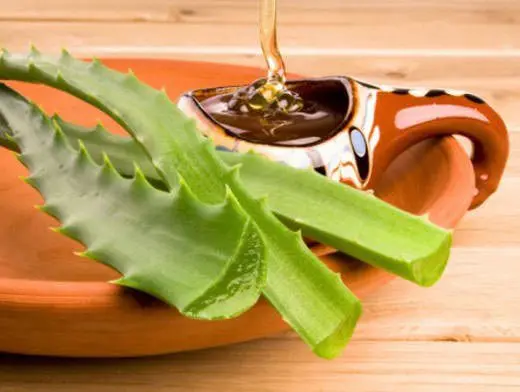
Honey is one of the main components that make up useful medicines made on the basis of aloe juice. In combination with honey, aloe enhances its effect. Due to the fact that such a medicine is very active, you can use it for no more than one month, with a cold, five days are enough for a complete recovery.
Aloe in combination with honey is useful for baldness, hair loss and dandruff. Aloe and honey can be used to make a hair mask.
To maintain immunity, you should take the following drugs:
Aloe tincture: 500 g of aloe leaves and 500 g of walnuts need to be ground through a meat grinder, pour 1,5 cups of honey, let it brew in a warm, dark place for three days. , and then consume one tablespoon three times a day after meals.
Mixture: three tablespoons of aloe juice, 100 g of cow butter, 5 tablespoons of cocoa and a third of a glass of bee honey must be mixed well. Before use, all components should be mixed well with 200 g of warm milk and drunk a little three times a day.
With pulmonary diseases, colds, bronchitis, the following composition helps:
Aloe tincture: 350 g of crushed aloe leaves, 100 g of alcohol and 750 g of red wine should be mixed in a glass or enamel bowl. It is recommended to store the product in a dark cool place. Adults take 1-2 tablespoons 20 minutes before meals, children after five years – 1 teaspoon.
For face useful honey mask with aloe, it suits any type of skin. When using medicines from aloe vera, the recommendations for their use should be strictly followed.
Aloe extract
Aloe extract is a clear liquid of light yellow or reddish-yellow color, bitter in taste. Available in ampoules for injection, as a solution for internal use, as well as juices, tablets, syrups. In liquid form, the extract should be taken 5 ml three times a day for half an hour before meals. Aloe extract is drunk for anorexia and diseases of the gastrointestinal tract, 5–10 ml twice a day, half an hour before meals.
Tablets are taken in 1 pc. three times a day for 15-20 minutes before meals. Subcutaneous injections are prescribed: for children under 5 years old – 0,2–0,3 ml, after 5 years – 0,5 ml, for adults – 1 ml. When using drugs, allergic reactions, increased pressure, diarrhea are possible.
Aloe vera for face
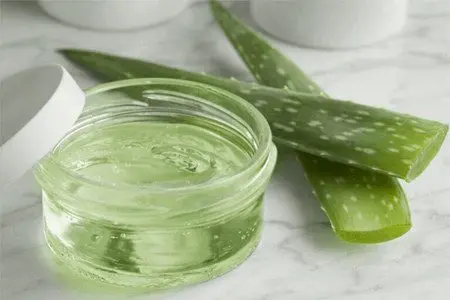
Aloe vera is used with great success in cosmetology. Masks and creams with aloe are recommended for use for sensitive skin prone to allergic reactions. Cosmetic products containing aloe vera enrich the skin with essential nutrients, protect it from environmental influences, and brighten in the presence of age spots.
Cosmetologists and dermatologists call aloe a panacea for maintaining beauty and health. Aloe vera is traditionally included in a wide variety of caring cosmetic products, the regular use of which has a truly miraculous effect on the skin.
1 Soothes sunburn
Aloe vera is the best natural remedy that saves the skin after sun and thermal burns. The gel based on it perfectly cools, relieves inflammation. After applying aloe, a protective film forms on the skin, which saves the skin from dehydration.
The process of regeneration of damaged skin cells is accelerated due to the rich mineral composition and high concentration of antioxidants.
2 Has a moisturizing effect
Usually, after applying a moisturizer, a sticky oily film is felt on the skin. Unlike conventional creams, aloe vera gel does not cause such sensations. The active substances of aloe help to cleanse the pores and soften the skin. Remarkable is the fact that the moisturizing effect extends even to the deep dermal layers, which is extremely useful for maintaining the moisture balance of dry skin.
Aloe is a great alternative to traditional aftershave products. Natural gel will not only moisturize the skin irritated by the razor, but also accelerate the healing of cuts and micro-cuts.
3 Stimulates the regeneration of wound surfaces
The application of aloe vera gel significantly reduces the healing process of skin lesions, regardless of origin. In medicine, aloe-based preparations are used in the treatment of cut wounds and other mechanical damage to the skin.
Aloe vera plays a special role in the healing of I-II degree burns. Studies have shown that its use accelerates the reproduction of new cells by almost 8 times. The penetration of the active substances of aloe into the outer layer of the skin is faster than the absorption of water.
4 Rejuvenates the skin
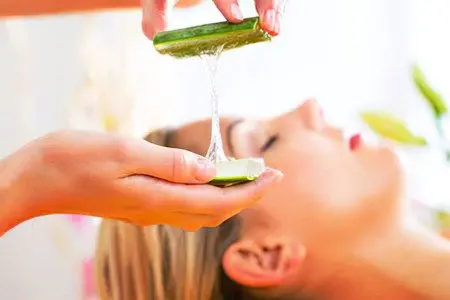
Aloe vera contains high doses of beta-carotene, ascorbic acid and vitamin E, known for their antioxidant properties. The combination of anti-inflammatory, antibacterial and antioxidant action of these compounds with other active substances provides the rejuvenating effect of aloe.
Regular use of aloe vera has a complex anti-aging effect:
Reduces pigmentation.
Smoothes wrinkles.
Stimulates collagen production.
Increases skin elasticity.
5 Helps deal with acne
Acne problem is easily solved with aloe vera. Being a natural antiseptic and antibiotic, aloe protects the skin from pathogenic flora, which provokes the appearance of various rashes, pimples, acne.
Aloe contains polysaccharides and gibberellins – substances that can alleviate the symptoms of inflammation, stimulate the growth of new skin cells. Due to the astringent effect, the functioning of the sebaceous glands is regulated, the pores are narrowed and excess sebaceous secretions, dirt, microbes are removed.
Regular application of aloe gel on problem skin allows you to clear it of acne, eliminate redness, avoid the appearance of unaesthetic scars, soften and protect it from damage.
6 Relieves pigmentation
Aloe vera gel is recognized as the best product for soothing irritated and inflamed skin, smoothing stretch marks and micro scars after acne. In addition, aloe can stimulate the renewal of skin cells and lighten pigmentation foci. Aloe vera is traditionally used in cosmetic products that lighten the skin and eliminate freckles.
At home, it is easy to prepare a natural composition that will help reduce freckles. It is enough to mix the aloe leaf gel with a little lemon juice. Regular application of the composition to the skin will provide it with a fresh, radiant look.
Regular use of masks and creams based on aloe for the skin of the face gives a striking effect, as they help with pustular rashes, inflammation, eczema and psoriasis.
Mask for dry skin: aloe juice, honey, glycerin and oatmeal must be mixed in clean water, beat with a blender, leave for 15 minutes, apply a thick layer on dry, cleansed skin. You can apply the mask every other day, keep it for about half an hour.
Mask for aging skin: mix a tablespoon of aloe juice and 2 tablespoons of honey. It is recommended to apply the mixture in a thick layer on cleansed skin and keep it for 40 minutes. The mask smoothes wrinkles and deeply moisturizes the skin.
Aloe for hair

Aloe leaf gel is a wonderful natural, hypoallergenic product that helps women and men solve all sorts of hair problems. Aloe has a beneficial effect on the scalp, helps with problems such as dandruff, hair loss, baldness. And the plant activates and nourishes the hair follicles, treats split ends. Hair becomes thick, strong and shiny.
1 Stimulates hair growth
Acting on the scalp, aloe vera has a stimulating effect on local blood circulation. The better the blood circulation in the area of the follicles, the faster the hair grows. Vitamins and minerals contained in aloe vera are fully absorbed by the scalp, healing it. The restoration of dead cells is carried out due to the action of proteolytic enzymes.
2 Eliminates dandruff
People with dry or excessively oily scalp are prone to dandruff. In addition, flakes on the hair are a symptom of a fungal infection of the scalp. Aloe vera has a complex effect on the skin, relieving all of the following problems:
Cleans.
Softens.
Suppresses the growth of fungal flora.
Regulates the sebaceous glands.
3 Has conditioning properties
Regular use of aloe vera gel after washing your hair has an effect similar to the effect of cosmetic conditioners. The result of the application is strong, energized, moisturized along the entire length, shiny hair.
Aloe Vera Recipes
If aloe vera grows on your windowsill, you can safely proceed to cosmetic procedures that will have a result no less than salon procedures. Arrange yourself home care with simple and affordable recipes.
Mask for hair volume and shine. One part of aloe juice, one part of castor oil and one part of honey must be mixed, applied to wet hair for a while, then rinse hair thoroughly with shampoo.
Moisturizing mask. Cut open an aloe vera leaf and scoop out the pulp with a tablespoon. Apply it on cleansed face and neck. Do a gentle massage. The remaining pulp can be removed with a napkin.
Mask for the eye area. Take a tablespoon of aloe vera gel, break open a vitamin E capsule and mix both ingredients. Apply the composition to the skin around the eyes with light, patting movements. Leave the mask on overnight. Wash your face with cool water in the morning.
Soft scrub. Combine 2 tablespoons of aloe vera pulp, 1 teaspoon of sea salt, and 1 tablespoon of honey in a glass bowl. Apply to the skin of the face and body, gently massage, rinse with water at a comfortable temperature.
Mask for problem skin. In a glass bowl, mix 1 tablespoon of aloe vera gel and honey, add 2 tablespoons of rose water. Stir until smooth. Apply to face 1-3 times a week for 10-20 minutes. Rinse off the rest of the mask with warm water.
Aloe in the nose
If a cold or runny nose begins, you can drip 5 drops of aloe extract into each nostril three times a day. Due to this, swelling of the nasal mucosa decreases, breathing becomes free. Pathogenic bacteria and viruses, including influenza, are destroyed, thus the mucous membrane is disinfected. If there is sensitivity to the components included in aloe juice, it is not recommended to use it.
Aloe leaves
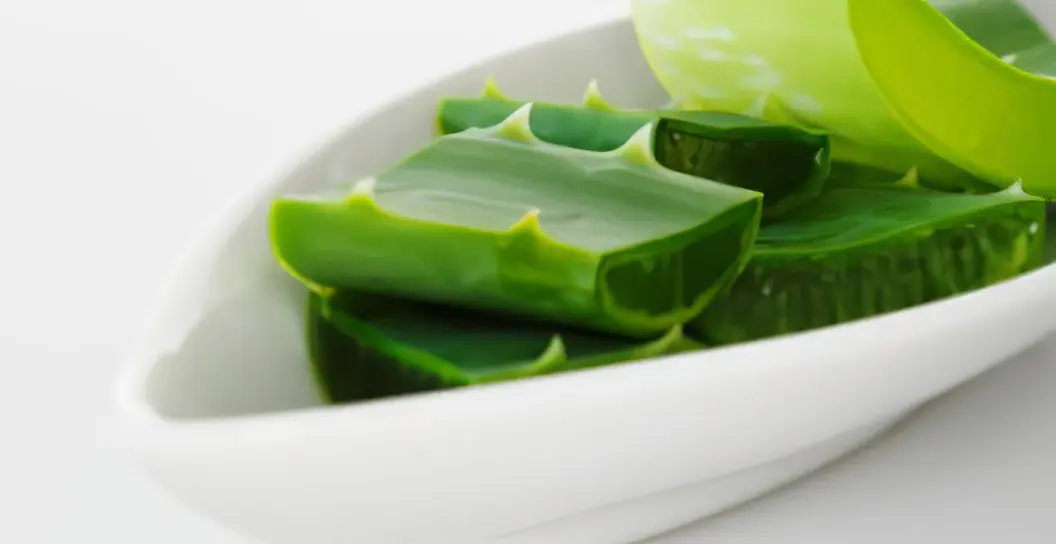
The most valuable thing in aloe is fleshy juicy leaves filled with bitter yellowish juice. You can collect them for medical use at any time of the year. But you just need to know which leaves are suitable. Healing are the lower leaves collected from a plant no younger than three years old. They usually have dry ends. It is best to break off the leaves from the stem.
In the open air, you should not store raw materials for more than three to four hours, as most of the useful properties are lost. So that the leaves do not dry out, you need to wrap them in a plastic bag and store in the refrigerator. So they will retain their medicinal properties for a long time. The leaves can also be dried by laying them out on a layer of paper and covering them with a cloth. You can store finished raw materials for two years.
Aloe tincture
The leaves and stems of the plant are used for tincture of aloe. Tinctures are liquid alcohol or vodka solutions prepared on the basis of medicinal plants. They are prepared on 40-70-degree alcohol, which is the best basis for herbal tinctures, as it enhances their healing properties. Tincture is used to stimulate the body’s defense systems, it increases appetite, improves digestion.
Aloe tincture recipe. Cut off the lower leaves of aloe, wrap in dark paper and put in the refrigerator for 1-2 weeks, then chop the leaves, pour vodka or a 70% alcohol solution in a ratio of 1:5. It takes at least ten days to insist the remedy in a dark, cool place, in a closed container. It is recommended to take tincture one teaspoon half an hour before meals 2-3 times a day.
Aloe for acne

The effectiveness of aloe juice for acne has long been known. It has a cleansing, healing, antibacterial, anti-inflammatory and healing effect. Thanks to this medicinal plant, you can prevent the appearance of scars, spots and scars, often formed after acne. The easiest way to get rid of skin inflammation is to regularly wipe your face with a small piece of aloe – the place where the flesh is cut. Before this, the skin must be cleansed.
Particular attention should be paid to problem areas of the skin. Professional cosmetologists often use aloe as an effective remedy for facial skin care.
Acne Face Mask: freshly cut aloe leaves need to be crushed, add protein and pass through a blender to make a gruel, then add a couple of drops of lemon juice. The mask should be applied in three layers and kept for 30 minutes, then rinsed with warm water.
Anti-inflammatory mask: it is necessary to mix freshly squeezed aloe juice with one teaspoon of white or blue clay, stir until a homogeneous mass is obtained and apply an even layer on the face, without talking and without making any mimic movements. It is recommended to keep the mask for 15 minutes, then it is washed off with cool water.
Lotions for skin inflammation: finely chopped aloe leaves should be poured with water and insisted for 1 hour, then boiled for two minutes, cooled, strained. The resulting liquid is used in the form of lotions.
Aloe in gynecology
In gynecology, aloe is used for cervical erosion, inserting tampons moistened with juice into the vagina for 2-3 hours. In the same way, they are treated with an emulsion containing aloe juice. Juice is taken one tablespoon three times a day after meals as a laxative for constipation in pregnant women, for chronic dysplasia in menopause and for cervical dysplasia. Aloe tincture is taken for acute inflammation of the vestibule of the vagina, 1 tablespoon three times a day before meals.
Tincture: aloe leaves should be crushed and mixed with honey until a homogeneous mass is obtained. Separately, you need to steam the dry leaves and flowers of St. John’s wort, boil them in a water bath for 3-4 minutes, strain, mix the mixture of aloe with honey with the cooled broth of St. John’s wort, pour wine and store in a dark, cool place. You can use the composition after 10 days. It is recommended to take it two tablespoons a day on an empty stomach. The course should be continued for 14 days.
Infertility Remedy: goose fat and sea buckthorn oil should be added to the crushed aloe leaves, mixed, poured into a warm dish and put for seven days in a dark, cool place. To use, you need to stir in a glass of hot milk one tablespoon of the mixture and take three times a day.
Aloe vera
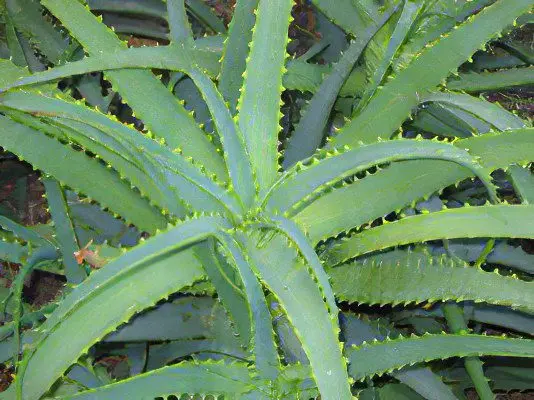
This evergreen perennial tropical plant reaches a height of 4–10 m. The leaves are fleshy, large, sharp, bluish-green or gray in color, up to 60 cm long. There are spines along the edges of the leaves. The root is highly branched. The flowers are bell-shaped, pale orange or bright red, collected in inflorescences, growing on a long stalk. The fruit is a cylindrical box; seeds numerous, greyish-black, trihedral. Tree-like aloe blooms most often in late winter and early spring. Propagated by cuttings.
Aloe vera is native to South Africa. In our area, it grows in the Transcaucasus and Central Asia. Aloe has long been domesticated, it is bred as an indoor flower. However, under indoor conditions, this plant rarely blooms, although with good care it can bloom every year. Aloe grows very quickly, reaching a height of up to 100 cm. Aloe leaves and juice have medicinal properties.
The leaves and stem contain various vitamins, resinous substances, anthraglycosides, and a small amount of enzymes. Leaves are collected in the autumn-winter period, it is advisable not to water for 1-2 weeks before collecting aloe.
Aloe vera
This plant is native to the tropics of Africa, so it loves sunlight very much. In summer, it grows well in open ground in the fresh air. It can be watered infrequently, as the leaves are able to retain moisture for several days. In winter, aloe should be watered with water at room temperature, and it is necessary to both water from above and pour water into the pan. But it is important not to overdo it: when the soil is waterlogged, the root system rots. In winter, the plant is best kept indoors with a temperature of + 8–10 ° C.

Both aloe vera and aloe vera are medicinal plants with the same chemical composition and are used in folk and traditional medicine. Juice is used for diseases of the gastrointestinal tract, treat eye diseases and inflammation. The plant is also widely used in cosmetology.
Contraindications to the use of aloe vera
Preparations from aloe vera are contraindicated in diseases of the liver and gallbladder, cystitis, hemorrhoids, the initial stages of pregnancy, as well as menstrual cycles.
To avoid insomnia, aloe juice should be taken 2-4 hours before bedtime. With prolonged use of drugs, minerals are removed from the body, especially potassium, which disrupts the water-salt metabolism.
For children under 12 years of age, a doctor’s consultation is required regarding the use of aloe.









